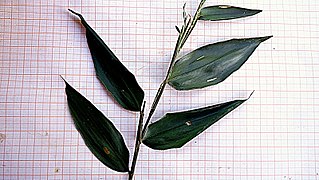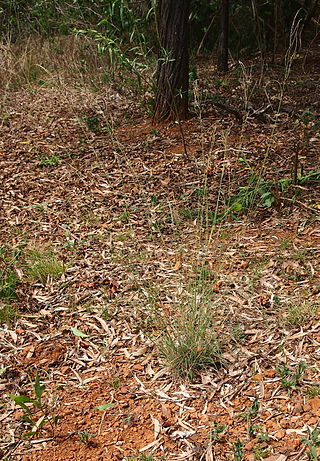
Panicum (panicgrass) is a large genus of about 450 species of Poaceae grasses native throughout the tropical regions of the world, with a few species extending into the northern temperate zone. They are often large, annual or perennial grasses, growing to 1–3 m (3–10 ft) tall.

Brachyelytrum is a genus of North American and East Asian plants in the grass family, classified in its own tribe Brachyelytreae.

Brachypodium is a genus of plants in the grass family, widespread across much of Africa, Eurasia, and Latin America. The genus is classified in its own tribe Brachypodieae.

Setaria is a widespread genus of plants in the grass family. The name is derived from the Latin word seta, meaning "bristle" or "hair", which refers to the bristly spikelets.

Axonopus is a genus of plants in the grass family, known generally as carpet grass. They are native primarily to the tropical and subtropical regions of the Americas with one species in tropical Africa and another on Easter Island. They are sometimes rhizomatous and many are tolerant of periodic submersion.

Lithachne is a genus of Neotropical plants in the grass family.
- Lithachne horizontalisChase - Minas Gerais, Rio de Janeiro, São Paulo, Mato Grosso
- Lithachne humilisSoderstr. - Honduras
- Lithachne pauciflora(Sw.) P.Beauv. - widespread from Jalisco to Paraguay
- Lithachne pinetii(C.Wright) Chase - Cuba

Sacciolepis is a genus of plants in the grass family. Cupscale grass is a common name for plants in this genus.

Steinchisma is a genus of plants in the grass family, native to the Americas but a few of them naturalized in Africa.

Streptogyna is a widespread genus of tropical plants in the grass family. It is the only genus in the monotypic tribe Streptogyneae.

Diarrhena, or beakgrain, is a genus of Asian and North American plants in the grass family.

Urochloa, commonly known as signalgrass, is a genus of plants in the grass family, native to tropical and subtropical regions of Eurasia, Africa, Australia, the Americas, and various islands.
Gymnopogon (skeletongrass) is a genus of American and Southeast Asian plants in the grass family.

Ichnanthus, commonly called bedgrass, is a genus of tropical plants in the grass family, widespread in Africa, Asia, Australia, and the Americas.

Leptochloa is a widespread genus of Asian, Australian, and American plants in the grass family.
Megastachya is a genus of African plants in the grass family.

Sclerochloa is a genus of Eurasian and North African plants in the grass family. Hardgrass is a common name for plants in this genus.

Paspaleae is a tribe of the Panicoideae subfamily in the grasses (Poaceae), native mainly to the tropical and subtropical Americas but with a number of species introduced to other regions. It includes roughly 680 species in 39 genera. Species in this tribe use either of the C3 or C4 photosynthetic pathways.

Paractaenum novae-hollandiae is a grass, native to Western Australia. It is an annual herb growing from 0.2 to 0.5 m high, on sands and loams. Its green-purple flowers may be seen from March to September.
















